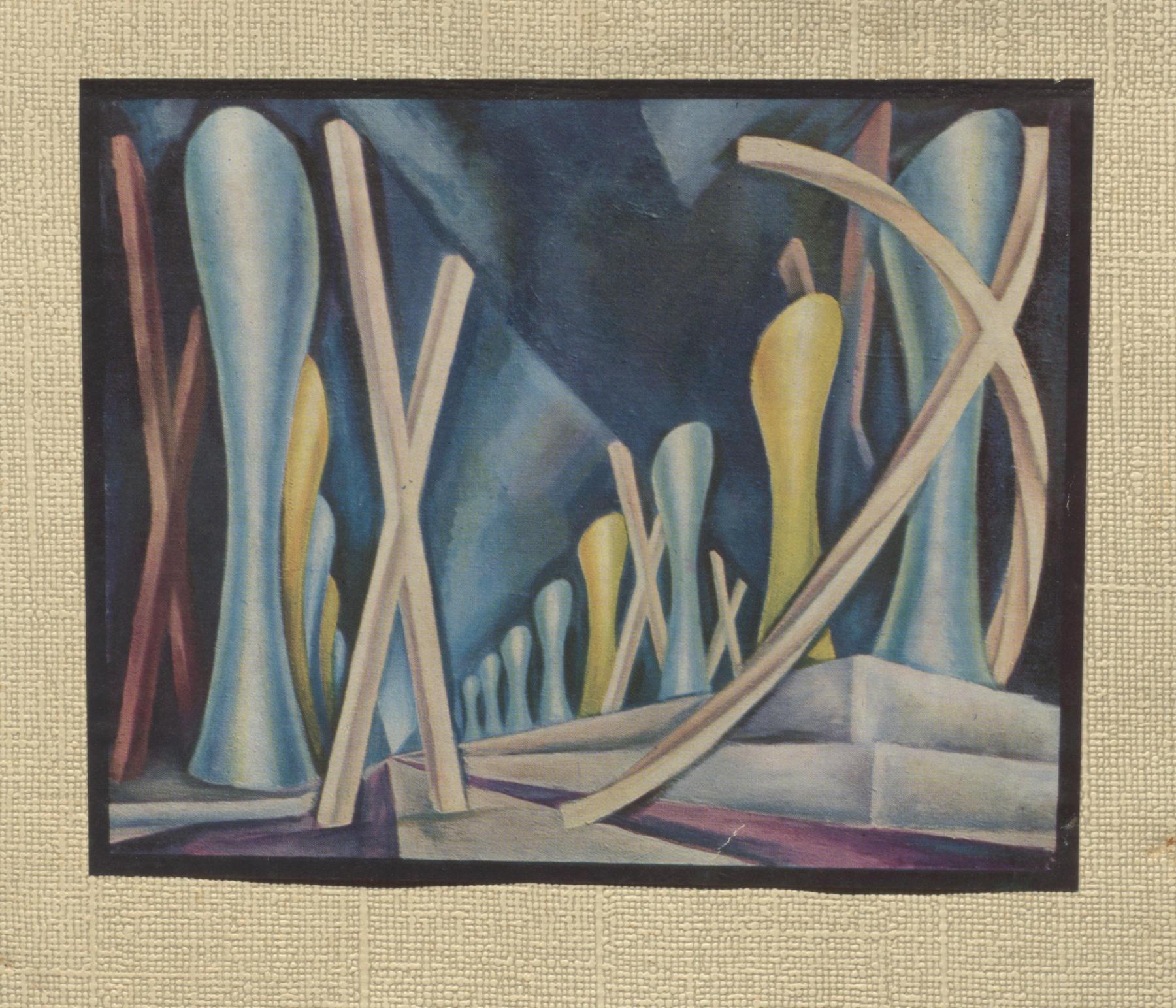Best Wishes for a Happy New Year

Folder Name: Ephemera
Object Identification Number: AL_056_7_8_01_6jpg
The location of this new year card in the archive.
I chanced upon this object, in a folder at the bottom of a long list. Weighing down on “ephemera” were critical documents, of significance. Along with this new year card, were other greeting cards, postcards. Some stark, without words, others bore no name, or citizenship, only an image.
This one, a star amongst the anonymous.
It had a date, an address, a name that changed a nation.
Father of
The Indian
Nuclear program
Physicist
Passionate about arts
Life worth living
His own painting
An Abstract on Two Themes
On a new year card
Reproduced
Posted
Sent
Art collector and friend
The Progressive Artists’ Group
Hussain, Souza, Bendre, Mehta, Gujral
Early paintings
Three hundred artworks!
With Best Wishes for A
Happy New Year
Homi Bhabha
December 1963
Mehrangir
12 Little Gibbs Road
Bombay 6
Overleaf, ABSTRACT ON TWO THEMES 1962
How do you read this image?
Is it black and white? Or is it coloured?
What do the colours say?
To each other?
Do you see people?
And/or objects?
How do we know they exist?
Why is seeing believing?
Are there people hiding?
Inside the image?
Who are they hiding from?
Is an image the best hiding place?
Woah!
This abstract on two themes is ensconced with other postcards from no-man’s-land, mass produced, shiny photos of food from apocryphal places etched on them. This is archival chance or divine design, I do not know.
Those stateless documents hide from me. I seek them. They peep from behind other papers, rush to conceal themselves when I turn the page. I find them! Those postcard hues— dragon chicken orange, porcelain blue, hieroglyphic green, they all yearn to be seen.
I write for permission to share them with the world:
Please may I request the use of…
Published/printed postcards, no copyright
All restaurant postcards, no copyright
In coming postcards, no copyright
View only, do not reproduce
Standard procedure
All archives
Our hands are tied
Happy New Year, perfectly fine!
Is the archive the best hiding place?
Woah!
Why did I fall for those bastard post cards?
Because they helped me commune with Joy Harjo?
Like those orphaned cards,
People are marooned
Waiting to be found
In the deep recesses of the archive.
Where no one looks
Where the catalogue ends
The folders fray
The search yields darkness.
To find the ghosts of lovers
Stories that lie in the dust between folders,
Use a poem as a map
But if it’s a famous poet,
First ask for permission.
Please may I request the use of…
The publishers of
From what we understand
Tell us the amount
Of the other poets
Suggest a one-time fee
That is acceptable
No royalty
No reproduction
Is a poem the best hiding place?
No royalty, no reproduction of the lines of a poet I love. But how do I explain, her words I read, are in me. I cannot unsee the phrases. I cannot annihilate the metaphors, I cannot swallow them whole. And pretend they do not exist. Her thoughts of burning an old year, are in my veins. How loyal do I have to be to be pay royalty? If a lover took my words and made it her own, I would sing with pride. Between literature owned by conglomerates and desires dictated by algorithms, I yearned to discover unknown verses, figures, folks that always sheltered between the cracks.
Exhausted.
I give up, content knowing they are hiding in wondrous places.
I’ll let the ghosts of mothers
And loverless lands,
And stateless objects
Live in obscurity
For eternity.
Between nations and wars
Permissions and royalties
Sanctity and chastity
Their burial is silent
Without a song
Perhaps their world ends here
Without human touch.
But for one,
There’s still “A Happy New Year”
It made it past the line
On top of the pile.
An abstract on two themes
An image of its time
By a name that changed a nation
It has an address and a date
A star amongst the unsigned.

Image Credit: I am grateful to the Archives at the National Centre for Biological Sciences (NCBS), Bangalore and Venkat Srinivasan for giving me access to the collection and to use these images. Homi Bhabha sent this new year card (a reproduction of his own painting), in 1963 to Obaid Siddiqi, founder of National Centre for Biological Sciences.
This is a work of fiction based on the writer’s many experiences as a researcher and performance maker.
In "Best Wishes for a Happy New Year", Anuja Ghosalkar treads two distinct sites, or as Anuja describes it, "hiding places"—a new year greeting penned by an eminent scientist in the Ephemera section of an archive, and a poem by Joy Harjo written at the occasion of new year's eve (Perhaps the World Ends Here). Studded with references and echoes, the technique of reiteration persists in unraveling that which is burrowed in verses and sheafs; an act of safekeeping for the hours yet to be.
Anuja Ghosalkar is the founder of Drama Queen, a documentary theatre company, in India since 2015. Her multi-disciplinary practice extends the idea of theatre to create audacious work, with a focus on personal histories, archival absences and blurring the hierarchies between audience and performer. Critical to her performance making and pedagogy are iterations around form and process, modes of (social) media, sites, technologies and reclaiming narratives on gender and intimacy.
Her performances, workshops and lectures have been programmed by University of Oxford, Hong Kong University, University of Cambridge, Jawaharlal Nehru University, Sophiensale, Serendipity Arts Festival, National Centre for Biological Sciences, Frankfurt University, Forum Transregionale –ZMO, among others. As visiting faculty at Srishti Institute of Art, Design and Technology, she leads practice-based pedagogy, and she has published extensively on film and performance.




